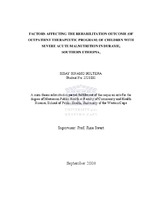| dc.description.abstract | Background: Malnutrition accounted high level of childhood morbidity and mortality in Ethiopia including Durame area. Durame area is one of the food insecure districts in Southern region. As a result of high prevlanece of acute malnutrtion, which is 8.3%, Ministry of Health partnering with World Vision Ethiopia started outpatient therapeutic program (OTP) in seven OTP sites to rehablitate severely malnourished children. Reports indicate that number of factors affect the rehabilitation outcome of children with severe acute malnutrtion in OTP programs. However, there are no studies conducted to assess their contribution in the rehablitaiton outcome. Hence, this study will attempt to investigate these factors and assess their public health significance in Durame area. Aim: To assess the factors affecting the rehabilitation outcome of an OTP for children with severe acute malnutrition in Durame area, Southern Ethiopia Method: the study used a descriptive study with an analytical component. Three-hundred and sixty (360) medical records were calculated during sampling and proportional numbers of medical records were sampled from the seven OTP sites. The medical records were reviewed using semi-structured questionnaires from September 1 to September 10,
2008. The data was entered and analyzed using EPI info version 3.3.2 software. Results: three hundred fifty five (98.6%) of the total sample records were reviewed. Three hundred twenty nine (92.7%) children were cured, 11(3.8%) died, 7 (2%) defaulted and 8 (2.3%) were non-cure. Average weight gain on discharge was 3.4gm/kg/day and the mean length of stay was 55.6 days (SD+14 days). More than 60% of children were admitted in
three of the seven OTP sites where Demboya OTP sites taking the larger share. Nearly half of the total children (49.8%) were between 6 to 12 months of age and the median age of admission was 13 months. The male to female ratio in the study population was almost equal. Average family size was 6.3 and 58.3% of children came from households with 6 or more family members. Forty two (11.8%) children in the study had twin. The average walking distance to the OTP sites was 62.9 minutes and two hundred fifty six mothers
travelled less than an hour. Most of the children (92.1%) were referred from the community and most of the children were admitted with MUAC followed by pitting edema. One hundred seventy four (49%) of the total children were beneficiaries of GFR. On admission two hundred twenty six
(63.7%) children were breastfeeding, 257 (72.4%) had no symptoms of sickness and 327 (92.1%) did not have abnormal physical examination findings. More than half (51.5%) of them did not receive any home visit and the larger share of the home visits (37.3%) were made when children got illnesses. One hundred sixteen (32.7%) children in the study had
chronic medical conditions during follow up. Fever or hypothermia (0.6%), dehydration (0.8%), anemia (0.6%), skin infection (1.6%) and Plumpy nut refusal (2.0%) were the main abnormal medical findings during follow up.
Assessment of the influence of the socio-demographic and biological characteristics on the rehabilitation outcome indicated that the sites, family size, chronic medical conditions, absenteeism, weight loss, presence of fever or hypothermia, dehydration and anemia had significant association with the treatment outcome (p<0.05). Further analysis for significant variables using regression analysis indicated that absenteeism, chronic medical illness, fever or hypothermia and anemia are predictor variables contributing significant
information for the prediction of the treatment outcome (p<0.05). Conclusion: The program has high success rate in terms of increasing cure and decreasing
death, default and non-cure rates but it did not meet the minimum international recommendations for average length of stay and average weight gain. The study identified the main socio-demographic and biological characteristics of children with SAM and factors that affect the rehabilitation outcome. Children under the age of 24 months were most affected with SAM and no gender variation. Larger proportions of malnourished
children were living in families above the average family size, which had significant association with the outcome. OTP sites were accessible for majority children in the program but higher level of absenteeism which significantly associated with the outcome. The study identified socio-demographic and biological factors that influenced the rehabilitation outcome as well as the predictor variables contributing significant information for the prediction of the treatment outcome. It could assist the program implementers to design appropriate public health measures. The achievement in Durame OTP program indicates effectiveness of community based management of SAM and existing potential to integrate in routine health system in resource scarce setting like Durame. Recommendations: to sustain the achievements and improve the growth areas necessary public health measures are prime importance. | en_US |

